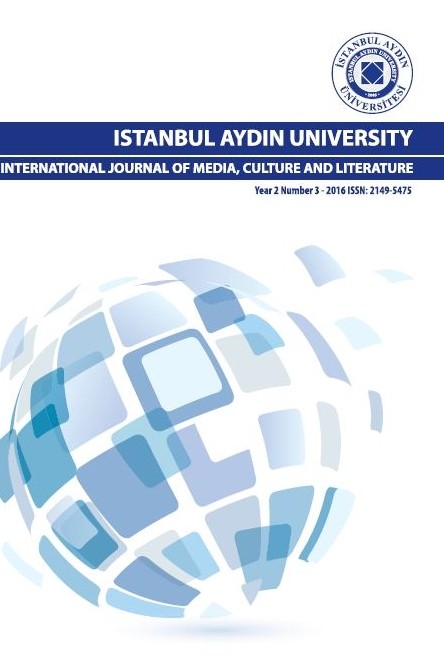Philip K. Dick’in Yüksek Şatodaki Adam Eserinde Postmodernizm
Philip K. Dick’ in çığır açan romanı Yüksek Şatodaki Adam bilim kurgu
türünün bir örneği olarak kabul edilse de, tarihi, politik ve kaşıt konusu
ile postmodernizmin izlerini taşır. Dick Müttefik devletlerin İkinci
Dünya Savaşı’nı kaybettiği, Almanların ve Japonların Dünyayı yönettiği
alternatif bir tarih oluşturmuştur. Dick, Nazi terörünü ve Alman ırkçılığını,
Japonya’nın uyguladığı Kapitalizmi gözler önüne serer ve Amerika savaşı
kaybetseydi nasıl bir dünya oluşurdu sorusunu yanıt olarak Amerika’dan
portreler çizer. Bu sorunun ışığında, Philip K. Dick, sömürüye dayanan
Batı felsefesinin eleştirisi, Kapitalizm ve bireyler üzerindeki etkileri,
ırkçılık ve soykırım gibi 20. Yüzyılın en belirgin konularını ele alır.
Yeniden yorumlanan ve şekillendirilen tarih olgusu, Kapitalist Batı
burjuvazi toplumunun eleştirisi, tekelci Kapitalist sistemde yalnızlaşan
ve yabancılaşan bireylerin sıkıntılarının ve de ırkçılık, soykırım ve
sömürgecilik politikalarının sonuçlarının irdelenmesi Yüksek Şatodaki
Adam okurunu postmodernizm ile buluşturur. Dick korkunç bir savaşın
etkilerini ve Amerika için sonuçlarını vurgular. Vietnam Savaşı’nın
başlangıcında basılan roman, Kapitalizme, sömürgeciliğe, ırkçılığa
dayalı Batı zihniyetinin eninde sonunda kendi kendisini yok edeceğine
dair Amerika’ya bir uyarı niteliğindedir. Böylece Dick, tüm kurumları
sorgulanan bir dönemin ürünü olan postmodern bir fantazide, yıkıcı bir
savaşın Amerika’daki etkileri üzerine okuyucuya birçok soru yöneltir.
Anahtar Kelimeler:
Postmodernizm, Değiştirilmiş Tarih, Eleştiri, Yabancılaşma, Kapitalist Sistem
Postmodernism in Philip K. Dick’s The Man in the Highcastle
Philip K. Dick’s The Man In The Highcastle is a pathbreaking novel that bears the traces of postmodernity with its contadictory, historical and political plot even though it is accepted in science fiction canon. Dick creates an alternative history in which the Allied forces lost the World War II and Germans and Japanese rule the world. Dick draws portraits from America posing the question what kind of a world would generate if America lost the war, displaying the German Nazi terror of fascism and Japanese performance of capitalism. In the shade of this question, Philip K. Dick covers a number of crucial topics of the twentieth century such as fascism and holocaust, monopolist capitalism and its results on individuals, a severe criticism of Western dominant ideology of expansion and exploitation. The presence of a reshaped and reinterpruted history, the criticism of Western dominant capitalist bourgeois society, the isolated and estranged individuals in monopoly capitalist system, underlying the results of cruel expansion policies, racism and holocaust cause the reader encounter with postmodernism in The Man in the Highcastle. Thus Dick highlights the results of a disastrous war in America by posing to the reader numerous questions in a postmodern fantasy that could be accepted as a fruit of an era totally under scrutiny with all its institutions.
Keywords:
Postmodernism, Alternative History, Criticism, Alienation, Capitalist System,
___
- Dick, P. K . (1981). The Man in the Highcastle. New York: Berkley Freedman, C. (2000). Critical Theory and Science Fiction . Middletown: Wesleyan University Press Hutcheon, L. (1988). A Poetics of Postm0odernism History, Theory, Ficton. New York : Routledge Eagleton, T. (2003). Literary Theory. Minneapolis : The University of Minnesota Press Edward, J., & Mendlesohn, F. (2012). The Cambridge Companion To Fantasy Literature. Cambridge: Cambridge University Press
- ISSN: 2149-5475
- Başlangıç: 2015
- Yayıncı: İstanbul Aydın Üniversitesi
